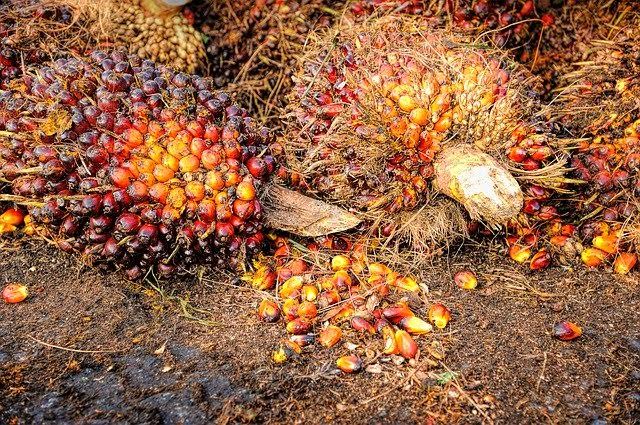By Christine Riney, AWC Hamburg
All-pervasive Palm oil is found in almost everything we use or eat every day. It is in day-to-day items where you wouldn’t even think to look for it, but there it is anyway – cookies, pizza, shampoo, soap, margarine, biofuel, cooking oil, peanut butter, washing detergent, chocolate, ice cream and even lipstick. And the list does go on.
Palm oil is found in almost everything we use or eat every day. It is in day-to-day items where you wouldn’t even think to look for it, but there it is anyway – cookies, pizza, shampoo, soap, margarine, biofuel, cooking oil, peanut butter, washing detergent, chocolate, ice cream and even lipstick. And the list does go on.
Palm oil is the cream of the crop in relation to vegetable oils. We have – or a least most of us have – become unwitting consumers of this almighty oil. But is it a good thing, or a bad thing, or both? That is a question we need to ask ourselves when we make our buying choices.
As with most things that become ubiquitous, we need to be informed consumers and make our own decisions on how to ensure sustainability in our choices – making sure we do our part to ensure responsible environmental management. For me, environment includes the human toll that irresponsible management can exact.
The most amazing vegetable oil of all
- When we were told that trans fats were bad for us, major consumer brands had to find a solution. They found a solution, and its name is palm oil.
- When our major consumer brands wanted a smoother lipstick, a better foaming washing powder, an ice cream that didn’t melt – palm oil was there.
- We demanded no more animal products in our purchases, and palm oil filled the bill.
- When industry and governments wanted a cheaper biofuel – palm oil was ready.
- It is a wonder oil that is virtually tasteless, easy to process, inexpensive to grow and an extremely high-yield plant. And perhaps most importantly, it is cheap to buy.
And thus, palm oil rose as the champion for all our vegetable oil requirements.
“Between 1995 and 2015, annual production quadrupled, from 15.2m tonnes to 62.6m tonnes. By 2050, it is expected to quadruple again, reaching 240m tonnes. The footprint of palm oil production is astounding: plantations to produce it account for 10% of permanent global cropland. Today, 3 billion people in 150 countries use products containing palm oil. Globally, we each consume an average of 8kg of palm oil a year.” – The Guardian, February 19, 2020.
 Not only does palm oil provide for wealthy countries’ insatiable appetite for consumables, but it supports poverty reduction schemes in countries including Indonesia, Malaysia and Nigeria. In India, it provides an excellent solution to the need of providing cheaper, healthier, edible oil to a growing population: palm oil is used for rations in the poorest districts. That is the upside, and it is wonderful and positive – but with the increased use and demand for this oil, the downside has become all too damaging.
Not only does palm oil provide for wealthy countries’ insatiable appetite for consumables, but it supports poverty reduction schemes in countries including Indonesia, Malaysia and Nigeria. In India, it provides an excellent solution to the need of providing cheaper, healthier, edible oil to a growing population: palm oil is used for rations in the poorest districts. That is the upside, and it is wonderful and positive – but with the increased use and demand for this oil, the downside has become all too damaging.
The environmental cost of the wonder oil
The quest for ever more palm oil is driving animals, including humans, to the brink of extinction as their habitat is cleared for more plants. Swaths of deforestation are pumping greenhouse gases into the atmosphere, and air pollution levels from burning for forest clearing are rising. Human rights violations are being perpetrated as profits soar, and regeneration has harmed those whom this wonderous palm plant is helping.
What can we do?
How can we help to ensure that we do not contribute to the extinction of the magnificent orangutan, keep air pollution and climate change in check, ensure sustainable livelihoods for  farmers and cheap, healthy cooking oil for countries most in need?
farmers and cheap, healthy cooking oil for countries most in need?
Banning palm oil is not the answer. Something else will take its place. Perhaps it will need more land, more water and even more of our valuable resources. To find a solution, we will need to support several different options.
- Alternatives to palm oil: synthetic palm oil is being researched and tested; less damaging vegetable oils or other non-vegetable alternatives are being investigated as substitutes for some uses of palm oil.
- Research is being conducted into the palm oil plant itself and ways to increase the yield of a single palm oil tree.
- Education is taking place at the farm level itself, working with farmers to encourage better practices.
Industry bodies have introduced sustainable guidelines for palm oil as well as a certification process: RSPO (Roundtable of Sustainable Palm Oil).
Governments have signed on to legislation to help regulate the palm oil industry: Sustainable Business.
We the consumers also have a role to play by lobbying governments and companies to ensure pressure and awareness of a more sustainable palm oil industry.
Make sure you know what is in the products that you buy: Palm Oil Free List
Encourage consumer goods companies to make sure they use sustainable options and monitor their supply chains: Palm Oil Score Card
Lobby governments to commit to sustainable targets, vote for those officials who stand on environmental platforms.
As with many of our environmental issues, we can be part of the solution by being informed consumers. We need to keep businesses and government accountable in a proactive way. Write letters, send emails, look for sustainable certified products at your local shop.
Resources:
Orangutan Foundation International
Photos: Pixabay

